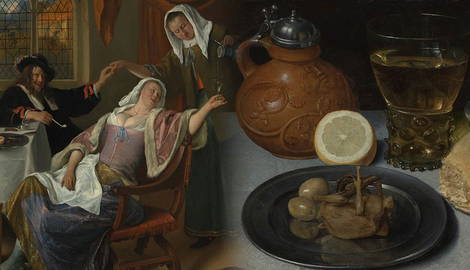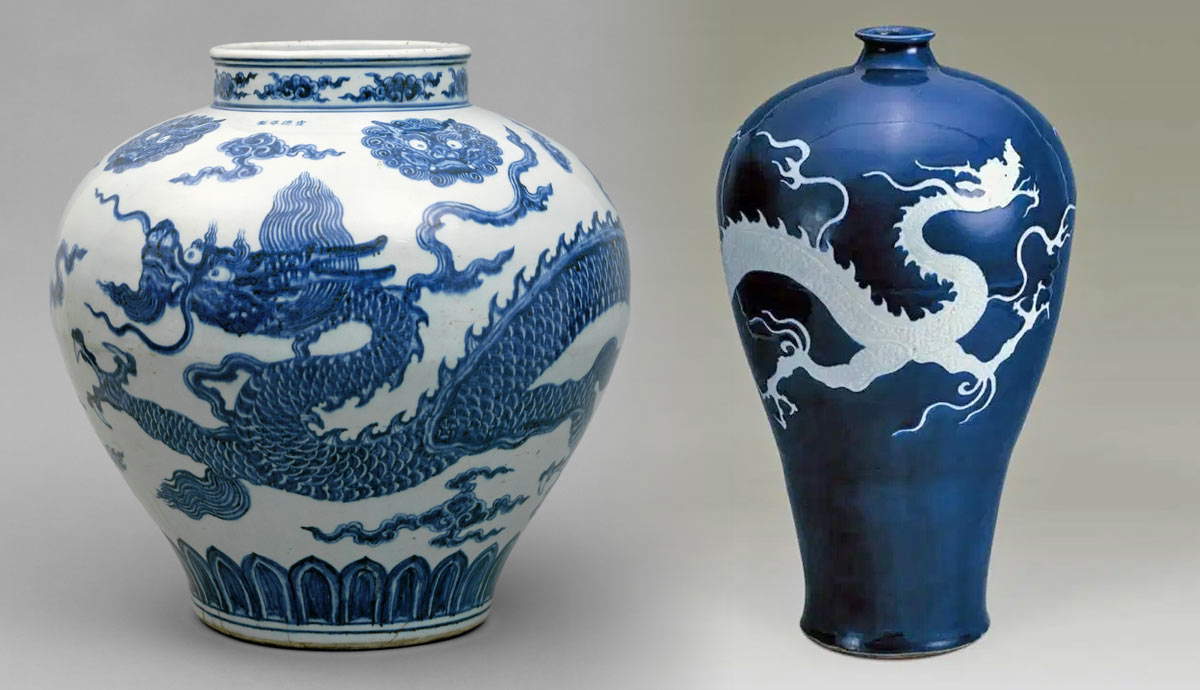
The art created throughout the Dutch Golden Age shone a light on the lives of ordinary individuals. This art not only represented everyday commonplace activities but also demonstrated the values, morals, and expectations of a Calvinist/Protestant life.
Domestic Settings of the Art of the Dutch Golden Age

During the Dutch Golden Age, religion played a significant role in shaping societal values. This shift affected the art produced during this time. The art was not explicitly religious, but there were themes of religious values subtly throughout.
Peter de Hooch’s painting, The Bedroom, depicts a mother and child standing in what appears to be their home. The mother is dressed in modest middle-class attire: a red blouse with a white collar, a full dark blue skirt, and a headdress covering her hair. She stands straight with an amused smirk while she folds what could be beige and olive-green curtains. The amused smirk is meant for the child who stands by the door with one hand on the latch, either just having gotten back from playing outside or about to leave.
The child gazes back at the woman with curiosity as if asking her to join in the fun or to extend their playtime. Holding a ball in one hand, the child clings to the door latch with the other. Dressed in earthy tones, the child wears a dark golden skirt, an olive-green sash, and a pale brown blouse.
The house’s interior is symmetrical, which helps balance the overall atmosphere. Two chairs frame the entrance, while ceramic pots on either side of the painting suggest a lively household filled with chores. A large wooden beam supports the interior, and the red tile floor reflects the light streaming through the open window and door. Above the doorway hangs a framed picture of a landscape.
This painting transforms everyday activities into something beautiful and revered, highlighting the importance of order, cleanliness, and tranquility. These values reflect the Calvinist beliefs of the time, illustrating how the sacred can be present in secular, everyday life.

In Gerard Ter Borch’s The Letter, the viewer gains access to another domestic setting, although this one is of an intimate, private moment. Three full-length figures occupy the space within the painting: a maid, a young boy, and a young woman holding a letter. The painting is set in an upper-class room anchored by a chandelier hanging from the ceiling. The lighting is soft, calm, and gentle as it shines predominantly on the young woman with the letter. How the young woman is illuminated in this soft, warm light can be likened to a holy scene. The careful, focused expression on the young woman’s face tells the viewer that she is fully absorbed in what the letter says.
To the forefront of the painting lies a small dog on top of a plush purple chair. The young maid and child both focus their attention on the young woman standing and reading. Both the maid and child seem to be impatiently waiting to hear what the letter contains as if it were the most important thing ever.

The young woman standing reading the letter is lavishly dressed: an ultramarine blue blouse paired with a silky satin skirt that touches the floor. Ter Borch has been praised for his attention to detail and the skillful way he depicts fabric with his brush strokes.
These two paintings, by Ter Borch and de Hooch, show contrasting views of Dutch Domestic settings, though they both demonstrate the secular sacredness prevalent in most Dutch paintings throughout the Dutch Golden Age. One demonstrated human connection and the reverence found in moments of solitude or contemplation. The other shows the viewer the home as a private sanctuary, where ordinary routines such as cleaning or child-rearing are portrayed with dignity and respect. These concepts tie closely with the Calvinist society of 17th-century Dutch citizens, where personal accountability was prominent.
Still Life and Vanitas

Still-life and Vanitas paintings accurately depict everyday objects, such as fruits, flowers, vases, spoons, forks, etc. However, the objects displayed often hold deeper meanings than what is surface-level. The meanings can vary from the fleeting nature of our mortal world to serve as a warning against vices such as gluttony and sloth.
Pieter Claesz’s Still Life with a Skull and a Writing Quill is an excellent example of a vanitas painting. In this painting, the viewer immediately notices the human skull fixed on a book and other writing materials. Next to the skull lies an empty glass tipped over on its side, a quill that appears to have been used recently, and an ink container on its side. On the left-hand side of the skull, there seems to be burning incense; beautiful smoke wafts away. It looks as though this scene is interrupted as if the individual sitting near the skull hurried and left—representing the fleeting nature of life. The book and paper the skull sits atop are skewed and jumbled together in a last-minute attempt to tidy up. The skull is missing a few front teeth, perhaps due to a sweet tooth that cannot be controlled. The color scheme of the painting is made up of dark, earthy tones such as copper red, forest green, and dark brown.
The painting not only reminds us of the mortal world we live in, with the skull as the primary symbol but it also sheds light on the transience of intellectual pursuits through the books that the skull sits atop. In this painting, the divine is very much intertwined with the secular.

Another example of still life or vanitas art can be seen in Georg Flegel’s work. Flegel was known for his meticulous arrangements of everyday objects, such as food, fruit, bread, and flowers. He set up these scenes in a way that imbued the objects with a sense of reverence, inviting viewers to reflect on the beauty and transient nature of life itself.
In the painting described, the viewer sees a table set with a loaf of bread, a lemon, a full glass of liquid, a jug, and a silver platter holding two greenish-yellow olives along with a cooked bird carcass. Nearby, a live bird is perched on the loaf of bread, grasping a walnut in its claws, which likely came from the walnut shell next to it. The live bird’s gaze is fixed on another bird with its leg or wing protruding from its head, resting on a plate after being cooked. This stark contrast between life and death would not have gone unnoticed by the 17th-century audience.
How Flegel depicts these items on the table with such delicate precision draws attention to their beauty and detail, particularly the bird. The lemon is also highly detailed; one could almost feel their mouth pucker at its inevitable sour taste. The wine in the glass is silky, smooth, and alluring, guaranteeing that it will quench the viewer’s thirst. Flegel’s attention to detail, texture, and precision has elevated these everyday items and creatures beyond their practical uses; they have become something else, something almost sacred. In that sacredness is an appreciation for the things that sustain life.
Dutch Golden Age Art: Moralizing Genre Paintings

Genre paintings in Dutch art closely resemble those depicting domestic settings discussed earlier. However, the critical difference lies in their focus on the less admirable aspects of life. These genre paintings often serve as cautionary tales, addressing issues such as drinking, infidelity, laziness, and other vices.
One example of a genre scene comes from Jan Steen and his painting, The Dissolute Household. The scene before us is, just as the title says, a dissolute household. Chaos ensues from every corner. A maid sleeps at the table while a young child messes with her headdress. The child seems confident that the maid will not awaken to catch him. Beyond them is an interaction between a beggar from the house’s window and another child. The child stares at the beggar in disbelief as he denies him any money while he holds a sword. The sword is not meant to be a weapon of defense but a symbol of the child’s future role in society as a soldier.

The central focus of the painting is a man and a woman who appear to be the artist himself and his wife. Steen looks at the viewer with a drunken smile, unaware of the straw basket above him containing ominous symbols. The sword and switch in the wicker basket above symbolize justice and punishment, the crutch and metal stand for a life of beggary, and the wooden clapper stands as a warning device assigned to lepers and the plague-stricken. Hanging above the basket is the Jack of Spades, which symbolizes overall bad luck.

Steen gently holds hands with a maid standing behind his wife as she pours a glass of wine—an embodiment of graceful multitasking. Steen’s wife leans back in her chair, displaying confidence and ease, unfazed by life’s concerns. Her foot rests on an open book, presumably the Bible, symbolizing the importance of wisdom. To the left, a cat with a tail resembling a rat attentively savors a piece of food, reminding us to appreciate life’s simple pleasures. To the right of the silver platter, a pocket watch with a ribbon serves as a poignant reminder of our mortality, urging us to pursue moderation and act with decorum.

In David Teniers the Younger’s Guardroom with the Deliverance of Saint Peter, the artist presents the moment of Saint Peter’s rescue. However, this rescue occurs in a disheveled guardroom instead of a holy setting. By placing this pivotal and holy event in a humble secular interior, Teniers promotes the idea of the sacred being found in everyday life.
The guardroom is busy, likely noisy, dimly lit, and cluttered with objects scattered haphazardly on the floor. All the guards are focused on playing cards, drinking, or chatting with each other; no one seems to notice what is happening outside the guardroom doors. Outside the doors, the viewer witnesses a very holy scene: the rescue of St. Peter. Peter and the angel are noticeably dressed in brighter, pastel colors, contrasted with the guards in their rough, dirty, and dark tones. The guard’s indifference to what is happening outside highlights the theme of human ignorance toward the divine and reminds viewers about the importance of attentiveness and faith.

The brightness of St. Peter and the angel’s clothes complement the soft glow of the light that envelopes them, contrasting with the dark and earthy tones of the interior guardroom. Again, this painting symbolizes divine presence and deliverance, which can occur even in dark and confining spaces. It also reminds the viewer to be mindful of their surroundings and not partake in worldly distractions that may lead them astray from the divine.
Whatever else is happening in the painting, the dog standing to the right and the clutter of metal and other objects to the left are seemingly unimportant to the overall moral of this painting, which instills the notion that the divine is happening everywhere, even to those who are unaware of its presence.
The art of the Dutch Golden Age masterfully blended the sacred with the mundane, highlighting the profound beauty and significance of everyday life. This unique approach enriched the viewer’s experience and invited a deeper reflection on the spiritual dimensions present in ordinary moments. By elevating simple scenes to a place of reverence, these works continue to resonate, reminding us of the inherent value in our daily lives.









